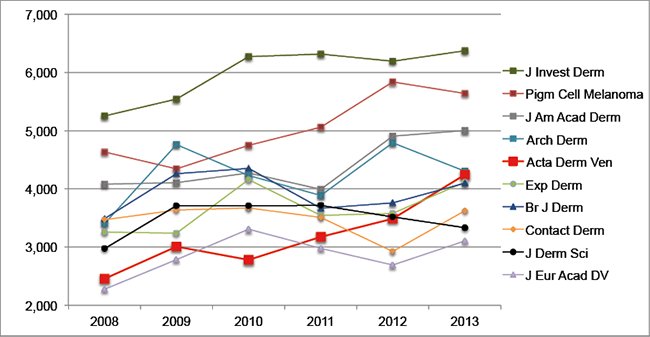A Successful 2014 Paves the Way for Acta Dermato-Venereologica’s Forthcoming Centenary
With an impact factor of 4.244 and nearly 600 new submissions in 2014, Acta Dermato-Venereologica is a vital 95-year-old journal that combines modern ideas of open access and on-line publication with a long tradition of high-quality peer-review and paper printing of scientific papers. The acceptance rate is currently in the order of 45%. To ensure a rapid publication of all accepted papers, the number of issues per volume will now increase to 8, corresponding to nearly 1,000 pages per year.
The prerequisites for this on-going success are manifolds: An Editorial Board with 18 distinguished Section Editors (SEs) from 10 different countries, a highly efficient editorial office, and being a non-profit publisher in our own capacity, allowing swift adaptations to changing demands from readers and academia.
As to the Editorial Board, I’m happy to introduce Professor Magnus Lindberg, MD, PhD, as the new SE for “Contact dermatitis and Case reports”. Professor Lindberg, at the University hospital in Örebro, Sweden, is a senior consultant specialised in occupational and environmental dermatology with more than 120 publications in this field. He – and the other SEs – are presented in more detail on our website (www.medicaljournals.se/acta), speaking of which had an all-time high number of visitors last year (> 452,000).
The number of downloads also exceeded our expectations (1,252,929). Surely, our open access policy is an important explanation to the increasing interest in our journal, also propelling the impact factor (Fig. 1). Additionally, our free app (ActaDermVen) provides easy access to all material published in Acta Dermato-Venereologica since volume 90.

Fig. 1. The impact factor for the top-10 journals in dermatology. Data from Science Citation Index (ISI).
Needless-to-say, running an open access journal without significant revenues from subscribers and advertisers requires that authors instead pay publication fees. Although these fees are kept as low as possible (no need for any profit!), we realise that for authors without research funding such fees may be problematic. Therefore we are always willing to negotiate the fee especially for authors from developing countries.
During 2015 our fruitful collaborations with the two special interest groups, IFSI (International Forum for the Study of Itch) and ESDaP (European Society of Dermatology and Psychiatry), will continue. The abstracts of the World Congress of Itch in Japan will appear in the September issue of Acta Dermato-Venereologica and a supplement entitled “Frontiers in Psychocutaneous Diseases – Selected Writings in Psychosomatics, Psychodermatology and Psycho-Neuro-Endocrine-Immunology”, dedicated to the memory of Prof. Emiliano Panconesi, the founder of ESDaP and past President of EADV, is planned for the ESDaP annual meeting in St Petersburg in June 2015.
We are confident and hopeful that all these measures combined will further increase the appeal of Acta Dermato-Venereologica and pave the way for a big 100-year anniversary in 2020!
Uppsala, January 2015
Anders Vahlquist, Editor-in-Chief
